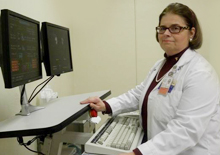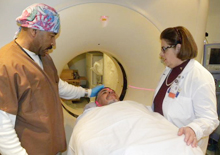| NYC Resources | 311 | Office of the Mayor |
|
|
Important notice on data breaches affecting some HHC patients |
Wiser Imaging to Reduce Radiation Exposure from CT Scans
When doctors need detailed internal images of human organs, they rely on computerized tomography – CT scans – a technology that produces a high-quality picture far more revealing than a conventional x-ray image. Yet the rapidly increasing use of this powerful tool has raised concerns about the risks of overexposure to ionized radiation used to make the images. At HHC, doctors and technologists recognized these risks and started addressing them several years ago to ensure improved care and greater safety for pediatric and adult patients. “CT scanners use X-rays to show cross sectional images of the body. They are an invaluable medical tool to help diagnose disease, rule out a disease or condition, and direct treatment,” said Dr. Paul Moh, Chief of Radiology at HHC's Lincoln Hospital. “But the risks associated with unnecessary or prolonged high-dose exposure can cause harm ranging from hair loss and irritation to more serious long-term risk of cancer.” "Our doctors have long been at the forefront of quality and patient safety with regard to imaging," said Dr. Roberta Locko, Director of Radiology at Harlem Hospital and Chair of HHC's Radiology Directors’ Council. “Our efforts have led to changes that reduce radiation dose, ensure that doctors request the right test for the right patient, and focus on staff communication and training to support our highly skilled technologist workforce.” As one of the leaders in this area, Dr. Locko pledged Harlem Hospital to the "Image Gently" campaign of the Alliance for Radiation Safety in Pediatric Imaging/Society for Pediatric Radiology in 2009. Between 2009 and 2011, the hospital lowered the already low doses given to children by 39 to 69 percent, depending on weight, while maintaining image integrity. The initiative was further expanded by the pledge in 2010 to “Image Wisely,” a national campaign endorsed by the American College of Radiology (ACR), the Radiological Society of North America (RSNA), American Society of Radiologic Technologists (ASRT) and the American Association of Physicists in Medicine (AAPM). The pledge confirmed Harlem Hospital's commitment to give the lowest dose possible to all patients of all ages. Dr. Locko has also hosted seminars entitled "Radiology for the Non-Radiologist," the most recent in December 2011, attended by more than 300 clinicians from HHC and non-HHC facilities. Attendees learned how to address situations that produce special imaging challenges, including pregnancy, breast imaging and ER imaging. At HHC’s Lincoln Hospital in the Bronx, the radiology team has focused on the need to reinforce the precise calibration of equipment and limit exposure to other parts of the body. They work closely with equipment manufacturers to make the necessary equipment adjustments to reduce radiation dose without compromising diagnostic image quality. "Reducing the dosage is not something we can easily 'dial down' on the machine, so we make sure our staff is highly trained and familiar with the equipment," said Dr. Moh, Radiology Chief at Lincoln. Radiology technologists at HHC must be licensed by New York State and certified by the American Registry of Radiologic Technologists. "We also achieved dose reduction with training for the technologists in proper positioning and by introducing breast and eye shields for patients." The efforts at Lincoln resulted in a reduction of CT radiation dosage of between 23 and 72 percent during late 2010 and early 2011, depending on patient's age and body area scanned. The team at Jacobi Medical Center in the Bronx used the Breakthrough performance improvement methodology embraced throughout HHC to make several changes that reduced their use of CT scans. The interdisciplinary team adopted a number of changes including having extended hours for a sonography (ultrasound) technician to be available between 5 and 10 pm, enabling ER doctors to order an ultrasound study during late hours as an alternative to a CT scan. During the 10 months following this change, 238 patients underwent ultrasound studies where they would have otherwise required a CT scan. With that and many of the same procedures adopted by other HHC hospitals, Jacobi realized a 14 percent decrease in the number of CT scans done from February 2010 to February 2011. "If patients understand the efforts that HHC hospitals are making in these areas for their safety, they will know that they are in good hands," said Dr. Locko.
| ||||||||||
HHC 2014 Stats
- Staffed Beds: 6,684
- Clinic Visits: 4,472,960
- ER Visits: 1,179,436
- Discharges: 205,791
- Births: 18,564
| Copyright 2015 The City of New York | Contact Us | Privacy Policy | Terms of Use |



